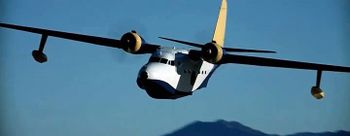Difference between revisions of "Category:Grumman HU-16 Albatross"
m (Protected "Category:Grumman HU-16 Albatross" ([edit=autoconfirmed] (indefinite) [move=autoconfirmed] (indefinite))) |
|||
| Line 1: | Line 1: | ||
| − | [[ | + | [[File:Vlcsnap-2012-05-27-23h10m10s143.jpg|thumb|right|350px|Grumman HU-16 Albatross seen in [[Act of Valor]].]] |
| − | The Grumman HU-16 Albatross is | + | The Grumman HU-16 Albatross is a large twin–radial engine amphibious flying boat that was used by the U.S. Air Force (USAF), the U.S. Navy (USN) and the U.S. Coast Guard (USCG), primarily as a search and rescue and combat search and rescue aircraft. Originally designated as the SA-16 for the USAF and the JR2F-1 and UF-1 for the USN and USCG, it was redesignated as the HU-16 in 1962. An improvement of the design of the Grumman Mallard, the Albatross was developed to land in open ocean situations to rescue downed pilots and other flight crew members. Its deep-V hull cross-section and substantial length enable it to land in the open sea. The Albatross was designed for optimal 4-foot (1.2 m) seas, and could land in more severe conditions, but required JATO (jet-assisted take off, or simply booster rockets) for takeoff in 8–10-foot (2.4–3.0 m) seas or greater. |
| + | |||
Latest revision as of 22:35, 20 October 2014

The Grumman HU-16 Albatross is a large twin–radial engine amphibious flying boat that was used by the U.S. Air Force (USAF), the U.S. Navy (USN) and the U.S. Coast Guard (USCG), primarily as a search and rescue and combat search and rescue aircraft. Originally designated as the SA-16 for the USAF and the JR2F-1 and UF-1 for the USN and USCG, it was redesignated as the HU-16 in 1962. An improvement of the design of the Grumman Mallard, the Albatross was developed to land in open ocean situations to rescue downed pilots and other flight crew members. Its deep-V hull cross-section and substantial length enable it to land in the open sea. The Albatross was designed for optimal 4-foot (1.2 m) seas, and could land in more severe conditions, but required JATO (jet-assisted take off, or simply booster rockets) for takeoff in 8–10-foot (2.4–3.0 m) seas or greater.
This page lists all films that feature a variation of the Grumman HU-16 Albatross.
See also
Pages in category "Grumman HU-16 Albatross"
The following 30 pages are in this category, out of 30 total.